Themed collection Polymer Chemistry Pioneering Investigators 2021

Pioneering investigators 2021
This themed issue of Polymer Chemistry highlights the work of pioneering investigators in the polymer chemistry field. Associate Editors Emily Pentzer and Holger Frey introduce the issue.

Polym. Chem., 2021,12, 1329-1346
https://doi.org/10.1039/D1PY90028E
Pairing Suzuki–Miyaura cross-coupling and catalyst transfer polymerization
Borylation strategies to make AB Suzuki–Miyaura monomers for use in catalyst-transfer polymerization with nickel or palladium catalysts.

Polym. Chem., 2021,12, 1404-1414
https://doi.org/10.1039/D0PY01507E
Direct formation of nano-objects via in situ self-assembly of conjugated polymers
The development of the polymer self-assembly method “in situ nanoparticlization of conjugated polymers” is discussed in this Perspective.

Polym. Chem., 2021,12, 1393-1403
https://doi.org/10.1039/D0PY01389G
Designing self-propagating polymers with ultrasensitivity through feedback signal amplification
Stimuli-responsive polymers with self-propagating degradation capacity being sensitive to acids, bases, fluoride ions, and hydrogen peroxide are reviewed, exhibiting self-accelerated degradation behavior.
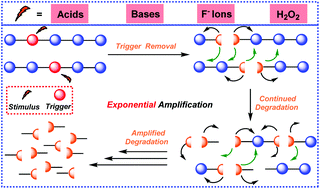
Polym. Chem., 2021,12, 6230-6241
https://doi.org/10.1039/D1PY01095F
Poly(ε-lysine) and its derivatives via ring-opening polymerization of biorenewable cyclic lysine
Minireview focused on poly(ε-lysine) and its derivatives via ring-opening polymerization of biorenewable cyclic lysine.
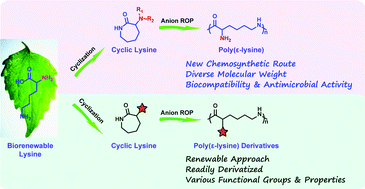
Polym. Chem., 2021,12, 1415-1424
https://doi.org/10.1039/D0PY01387K
Advancing the stimuli response of polymer-based drug delivery systems for ocular disease treatment
Recent exploitations of stimuli-responsive polymers as ophthalmic drug delivery systems for the treatment of eye diseases are summarized and discussed.

Polym. Chem., 2020,11, 6988-7008
https://doi.org/10.1039/D0PY00919A
Bioinspired structural color nanocomposites with healable capability
This minireview summarizes the recent development of healable structural color nanocomposites from the perspective of the construction strategies.

Polym. Chem., 2020,11, 6413-6422
https://doi.org/10.1039/D0PY01096K
Recent development in halogen-bonding-catalyzed living radical polymerization
The development and applications of an organocatalyzed living radical polymerization via halogen-bonding catalysis, i.e., reversible complexation mediated polymerization (RCMP), are highlighted.
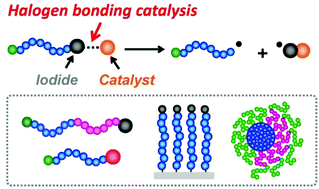
Polym. Chem., 2020,11, 5559-5571
https://doi.org/10.1039/D0PY00939C
From terpenes to sustainable and functional polymers
The use of renewable terpene-based monomers for the preparation of sustainable functional polymers is highlighted.
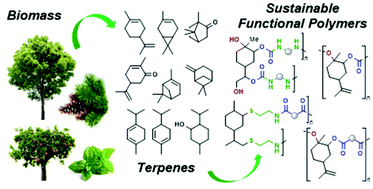
Polym. Chem., 2020,11, 5109-5127
https://doi.org/10.1039/D0PY00817F
Heterogeneous photocatalytic reversible deactivation radical polymerization
Photocatalytic reversible deactivation radical polymerization (RDRP) permits the use of sustainable solar light for spatiotemporal regulation of radical polymerization under mild conditions.
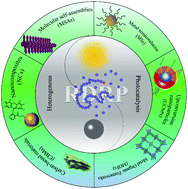
Polym. Chem., 2021,12, 2357-2373
https://doi.org/10.1039/D1PY00130B
Synthetic approaches for copolymers containing nucleic acids and analogues: challenges and opportunities
Deep integration of nucleic acids with synthetic polymers are rapidly becoming the basis of many useful technologies.
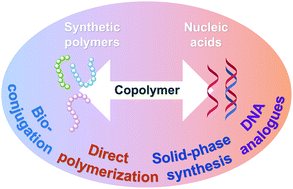
Polym. Chem., 2021,12, 2193-2204
https://doi.org/10.1039/D0PY01707H
Polymers and boron neutron capture therapy (BNCT): a potent combination
This review describes the latest polymeric systems used as boron transporters for boron neutron capture therapy.

Polym. Chem., 2021,12, 2035-2044
https://doi.org/10.1039/D0PY01392G
Semiflexible polymer scaffolds: an overview of conjugation strategies
Semiflexible polymers are excellent scaffolds for the presentation of a wide variety of (bio)molecules. This manuscript reviews advantages and challenges of the most common conjugation strategies for the major classes of semiflexible polymers.

Polym. Chem., 2021,12, 1362-1392
https://doi.org/10.1039/D0PY01662D
Quinoidal conjugated polymers with open-shell character
Quinoidal π-Conjugated polymers with open shell character represent an intriguing class of macromolecules in terms of both fundamental research and practical applications.

Polym. Chem., 2021,12, 1347-1361
https://doi.org/10.1039/D0PY01298J
Recent advances in the development and applications of nonconventional luminescent polymers
Recently, nonconventional luminescent polymers (NLPs) have emerged as the most sought-after alternative luminescent materials. This review provides a thorough description of the importance and applications of each class of state-of-the-art NLPs.
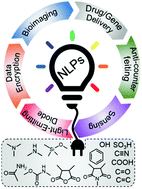
Polym. Chem., 2020,11, 7293-7315
https://doi.org/10.1039/D0PY01285H
A comprehensive review of the structures and properties of ionic polymeric materials
This review focuses on the mechanistic approach, the structure–property relationship and applications of ionic polymeric materials.
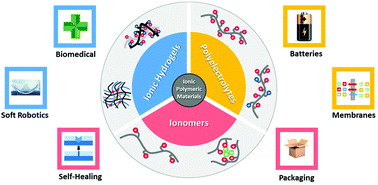
Polym. Chem., 2020,11, 5914-5936
https://doi.org/10.1039/D0PY00770F
Guanidium-functionalized cationic molecular umbrellas as antibacterial agents
We report the synthesis of guanidinium-functionalized cationic dendrons with pendant alkyl chains of varying lengths, which are classified as antibacterial cationic molecular umbrellas.
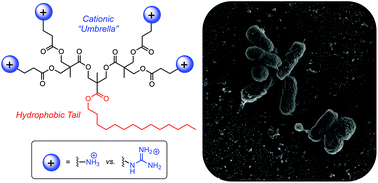
Polym. Chem., 2021,12, 2374-2378
https://doi.org/10.1039/D1PY00071C
Controlling properties of thermogels by tuning critical solution behaviour of ternary copolymers
Thermogelling tri-block terpolymers were made from a bifunctional PEG RAFT agent. The critical solution behavior was tunable by alteration of the terpolymer composition, enabling modulation of gelation temperatures and hydrogel viscoelasticity.

Polym. Chem., 2021,12, 1918-1923
https://doi.org/10.1039/D0PY01696A
A shish-kebab-like supramolecular polymer and its light-responsive self-assembly into nanofibers
We report a shish-kebab-like supramolecular polymer (SKSP) and its light-responsive self-assembly into nanofibers.
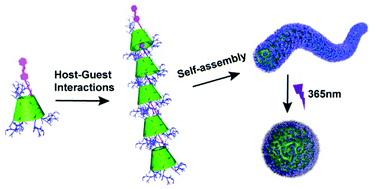
Polym. Chem., 2021,12, 1425-1428
https://doi.org/10.1039/D0PY01396J
Confined supramolecular polymers in water with exceptional stability, photoluminescence and chiroptical properties
Lipid-encased chiral supramolecular polymer nanorods (SPNRs), synthesized by the nanoprecipitation method in water from a hydrophobic naphthalene-diimide derivative, exhibit excellent thermal stability, intense fluorescence and strong CPL.
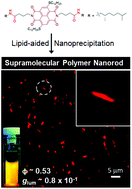
Polym. Chem., 2020,11, 7481-7486
https://doi.org/10.1039/D0PY01329C
Mechanism and application of surface-initiated ATRP in the presence of a Zn0 plate
SI-Zn0-ATRP enables the synthesis of chemically different polymer brushes under full ambient conditions, using just microliter volumes of reaction solutions.
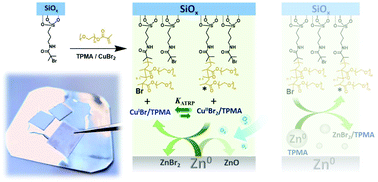
Polym. Chem., 2020,11, 7009-7014
https://doi.org/10.1039/D0PY01233E
Substituent effects in iniferter photopolymerization: can bond homolysis be enhanced by electronics?
Substituent effects on the dithiobenzoate moiety of RAFT iniferters are investigated. Donating groups accelerate the iniferter process, while withdrawing groups slow it. The unique efficiency of the methoxydithiobenzoate iniferter was uncovered.
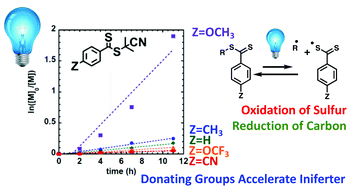
Polym. Chem., 2020,11, 6129-6133
https://doi.org/10.1039/D0PY01086C
Catalyst free removal of trithiocarbonate RAFT CTAs from poly(vinylpyridine)s using tris(trimethylsilyl)silane and light
Trithiocarbonate end groups on various polymers, including polyvinylpyridines, are reduced rapily and quantitatively using only tris(trimethylsilyl)silane and light.

Polym. Chem., 2020,11, 5962-5968
https://doi.org/10.1039/D0PY01104E
Easily readable palindromic sequence-defined polymers built by cascade thiol-maleimide Michael couplings
The rational combination of cascade thiol-maleimide Michael couplings (CTMMC) with iterative exponential chain growth was demonstrated as an efficient way to synthesize palindromic sequence-defined polymers.

Polym. Chem., 2020,11, 5974-5980
https://doi.org/10.1039/D0PY01088J
Cationic amphiphilic alternating copolymers with tunable morphology
A series of ionic amphiphilic alternating copolymers were characterized via SAXS, TEM and DLS to understand how factors such as covalent structure, and solvent environment affect self-assembly.

Polym. Chem., 2020,11, 5424-5430
https://doi.org/10.1039/D0PY00782J
Crosslinked metallo-polyelectrolytes with enhanced flexibility and dimensional stability for anion-exchange membranes
We report a class of crosslinked metallo-polyelectrolytes as anion exchange membranes with exceptional mechanical flexibility, dimensional stability and ionic conductivity.
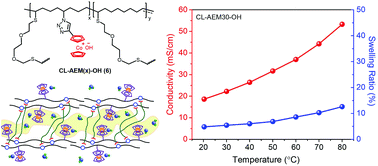
Polym. Chem., 2020,11, 4542-4546
https://doi.org/10.1039/D0PY00757A
Mesoporous polyetherimide thin films via hydrolysis of polylactide-b-polyetherimide-b-polylactide
Hydrolyzing polylactide-b-polyetherimide-b-polylactide triblock copolymers produces mesoporous polyetherimide thin films with an average pore width of 24 nm.
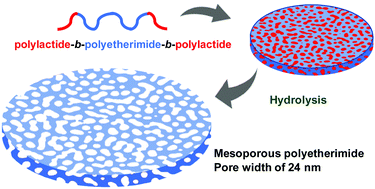
Polym. Chem., 2021,12, 3939-3946
https://doi.org/10.1039/D1PY00601K
Photoresponsive glyco-nanostructures integrated from supramolecular metallocarbohydrates for the reversible capture and release of lectins
Photo-controllable capture and release of proteins by glyco-nanostructures.

Polym. Chem., 2021,12, 3096-3104
https://doi.org/10.1039/D1PY00146A
Co-assembly of precision polyurethane ionomers reveals role of and interplay between individual components
In a novel synthetic approach, we have prepared sequence-defined waterborne polyurethanes and have studied their (co)-assembly to hydrocolloids; we find that especially the interplay between the sequences promotes the formation of stable micelles.

Polym. Chem., 2021,12, 2891-2903
https://doi.org/10.1039/D1PY00079A
The effect of polarity on the molecular exchange dynamics in imine-based covalent adaptable networks
Polarity-induced effects in dynamic covalent polyimine CANs were studied, revealing a three-step stress relaxation process.
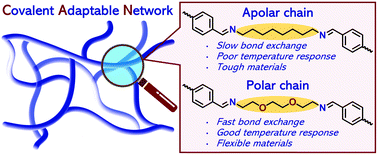
Polym. Chem., 2021,12, 1635-1642
https://doi.org/10.1039/D0PY01555E
The contribution of intermolecular forces to phototropic actuation of liquid crystalline elastomers
Azobenzene-functionalized crystalline elastomers containing a monomer with reduced aromatic content exhibits enhanced phototropic response.

Polym. Chem., 2021,12, 1581-1587
https://doi.org/10.1039/D1PY00028D
Design of an n-type low glass transition temperature radical polymer
We document the design, synthesis, and characterization of the first low glass transition temperature, n-type (i.e., preferentially-reduced) radical polymer.

Polym. Chem., 2021,12, 1448-1457
https://doi.org/10.1039/D0PY01645D
Expanding the thiol–X toolbox: photoinitiation and materials application of the acid-catalyzed thiol–ene (ACT) reaction
Kinetics of the acid-catalyzed thiol–ene (ACT) reaction were explored over a range of thiol and vinyl functional groups. Its applicability in material synthesis was demonstrated in the design of photopolymerized polymer networks.
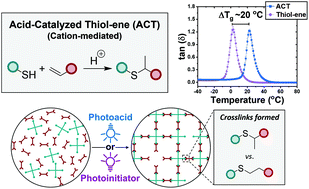
Polym. Chem., 2021,12, 1562-1570
https://doi.org/10.1039/D0PY01593H
Organocatalyzed closed-loop chemical recycling of thermo-compressed films of poly(ethylene furanoate)
Poly(ethylene furanoate) (PEF) films were first produced using thermo-compression. Thereafter, the chemical recyclability was demonstrated in the presence of a thermally stable organocatalyst followed by its repolymerization.
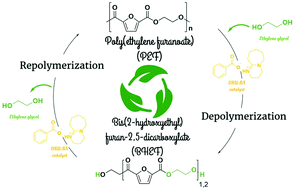
Polym. Chem., 2021,12, 1571-1580
https://doi.org/10.1039/D0PY01623C
Controlled ring-opening polymerization of N-(3-tert-butoxy-3-oxopropyl) glycine derived N-carboxyanhydrides towards well-defined peptoid-based polyacids
Polypeptoids bearing carboxylic acid groups on the N-substituent are useful building blocks for the construction of peptidomimetic supramolecular assemblies with stimuli-responsive properties.

Polym. Chem., 2021,12, 1540-1548
https://doi.org/10.1039/D0PY01395A
Effect of backbone and end-group regioisomerism on thermomechanical properties of vanillin-based polyurethane networks
Monomer composition, geometry, cross-link density, and cross-link distribution are the primary determinants of material properties in thermosetting networks.

Polym. Chem., 2021,12, 1526-1532
https://doi.org/10.1039/D0PY01578D
Clarification of the effects of topological isomers on the mechanical strength of comb polyurethane
We demonstrated the mechanical enhancement behavior of the comb polyurethanes by the topological isomer system between the linear and comb polyurethane. Also, we assumed the mechanical enhancement mechanism by the rheological properties.

Polym. Chem., 2021,12, 1533-1539
https://doi.org/10.1039/D0PY01391A
An AIE-driven fluorescent polysaccharide polymersome as an enzyme-responsive FRET nanoprobe to study the real-time delivery aspects in live cells
An enzyme-responsive FRET nanoprobe was designed and developed based on AIE-driven fluorescent polysaccharide polymersomes to study the real-time delivery aspects in the intracellular compartments in live cancer cells.
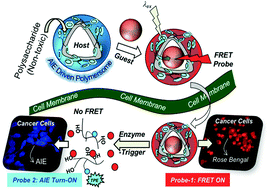
Polym. Chem., 2021,12, 1549-1561
https://doi.org/10.1039/D0PY01085E
A pyridinium-pended conjugated polyelectrolyte for efficient photocatalytic hydrogen evolution and organic solar cells
A pyridinium-pended conjugated polyelectrolyte with photo-induced amine doping behaviour was designed for multiple applications.
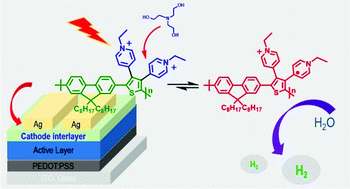
Polym. Chem., 2021,12, 1498-1506
https://doi.org/10.1039/D0PY01351J
Solution size variation of linear and dendritic bis-MPA analogs using DOSY-1H NMR
The size and size variability of bis-MPA dendrimers is shown to be smaller by DOSY-1H NMR than their linear analog, PBBM. This was accomplished using five different solvents and for the first time confirms, experimentally, what has been theorized.
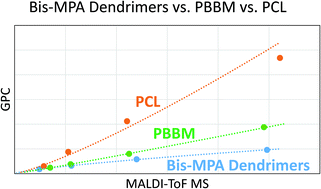
Polym. Chem., 2021,12, 1507-1517
https://doi.org/10.1039/D0PY01070G
Advanced spectroscopy, microscopy, diffraction and thermal analysis of polyamide adhesives and prediction of their functional properties with solid-state NMR spectroscopy
Advanced spectroscopy, microscopy, diffraction and thermal analysis reveal heterogeneity and dynamics in polyamide industrial adhesives; solid-state NMR spectroscopy enable the prediction of their functional properties.
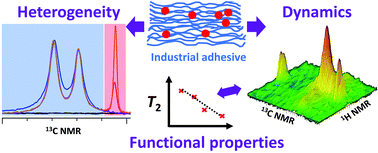
Polym. Chem., 2021,12, 1487-1497
https://doi.org/10.1039/D0PY01348J
Stereoselective polymerization of rac-lactide catalyzed by zwitterionic calcium complexes
Two zwitterionic calcium complexes L1CaN(SiMe3)2(THF) (1) and L2CaN(SiMe3)2 (2) via protolysis reaction were synthesized. At −75 °C, 1 gave a heterotactic sequence enriched polylactide, whilst 2 produced an isotactic sequence enriched polymer.

Polym. Chem., 2021,12, 1518-1525
https://doi.org/10.1039/D0PY01397H
Hierarchical self-assembly of miktoarm star copolymers with pathway complexity
The self-assembly of amphiphilic miktoarm star copolymers shows hierarchical pathway complexity from molecular building blocks to miktoarm stars to micellar nano-objects to complex hierarchical assemblies.
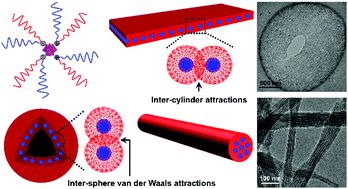
Polym. Chem., 2021,12, 1476-1486
https://doi.org/10.1039/D0PY01170C
Amphiphilic random and random block terpolymers with PEG, octadecyl, and oleyl pendants for controlled crystallization and microphase separation
Amphiphilic random and random block terpolymers bearing PEG chains, crystalline octadecyl groups, and amorphous oleyl groups were designed to control crystallization and microphase separation in the solid state.
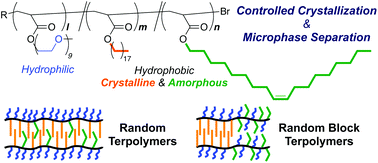
Polym. Chem., 2021,12, 1439-1447
https://doi.org/10.1039/D0PY01505A
Preparation of well-defined 2D-lenticular aggregates by self-assembly of PNIPAM-b-PVDF amphiphilic diblock copolymers in solution
PNIPAM-b-PVDF amphiphilic block copolymers were synthesized via RAFT polymerization in dimethyl carbonate. These block copolymers were able to self-assemble into various morphologies such as spherical, crumpled, lamellar and lenticular 2D aggregates.
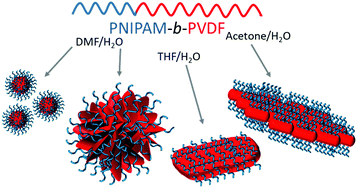
Polym. Chem., 2021,12, 1465-1475
https://doi.org/10.1039/D0PY01193B
Organocatalytic ring-opening polymerization of thionolactones: anything O can do, S can do better
Organocatalysts facilitate the synthesis of polythionolactones; oxidative crosslinking yields a degradable polymer foam.

Polym. Chem., 2021,12, 1458-1464
https://doi.org/10.1039/D0PY01393E
Naked micelles: well-defined polymer nanoparticles from photo-cleavable block copolymer micelles
We report that photo-cleaving the corona of block copolymer micelles provides well-defined nanoparticles with surface charges accessible for electrostatic modification.
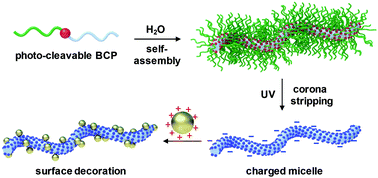
Polym. Chem., 2021,12, 1429-1438
https://doi.org/10.1039/D0PY01408G
Temperature-mediated molecular ladder self-assembly employing Diels–Alder cycloaddition
Thermal annealing of sequence-defined, maleimide- and furan-bearing oligomers enables sequence-selective hybridization to afford molecular ladders incorporating Diels–Alder adduct-based rungs.

Polym. Chem., 2020,11, 7714-7720
https://doi.org/10.1039/D0PY01296C
Thermo- and oxidation-sensitive poly(meth)acrylates based on alkyl sulfoxides: dual-responsive homopolymers from one functional group
Alkyl sulfoxide side groups introduce thermo- and oxidation-sensitivity into poly(meth)acrylates, thus realizing new dual-responsive homopolymers based on one functional group.

Polym. Chem., 2020,11, 7662-7676
https://doi.org/10.1039/D0PY01321H
Guaiazulene revisited: a new material for green-processed optoelectronics
Oxidative polymerization of naturally-derived guaiazulene with earth-abundant iron oxidants produces a low bandgap polymer for optoelectronic applications.

Polym. Chem., 2020,11, 7656-7661
https://doi.org/10.1039/D0PY01355B
Gradient and asymmetric copolymers: the role of the copolymer composition profile in the ionization of weak polyelectrolytes
The ionization of weak polyelectrolytes can be altered by controlling the composition profile of the comonomers along the chain.

Polym. Chem., 2020,11, 7562-7570
https://doi.org/10.1039/D0PY01059F
Dynamic covalent exchange in poly(thioether anhydrides)
Dynamic covalent exchange (DCE) of anhydride moieties is examined in both model compounds and network polymers.
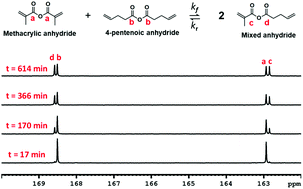
Polym. Chem., 2020,11, 7551-7561
https://doi.org/10.1039/D0PY01267J
Investigations into CTA-differentiation-involving polymerization of fluorous monomers: exploitation of experimental variances in fine-tuning of molecular weights
Condition and substrate effects on CTA-differentiation-involving polymerization were explored for logical control of molecular weight.
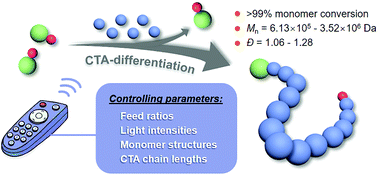
Polym. Chem., 2020,11, 7402-7409
https://doi.org/10.1039/D0PY01366H
Poly(vinyl acetate-co-ethylene) particles prepared by surfactant-free emulsion polymerization in the presence of a hydrophilic RAFT/MADIX macromolecular chain transfer agent
Poly(vinyl acetate-co-ethylene) latexes are prepared under a broad range of conditions by emulsion polymerization in the presence of a hydrophilic RAFT/MADIX macromolecular chain transfer agent.

Polym. Chem., 2020,11, 7410-7420
https://doi.org/10.1039/D0PY01266A
Defect engineering of polyethylene-like polyphosphoesters: solid-state NMR characterization and surface chemistry of anisotropic polymer nanoplatelets
Polyethylene-like polyphosphoesters crystallized from dilute solution into anisotropic nanoplatelets. As proven by solid-state NMR, the phosphate groups are expelled to the surface and on-surface chemistry was conducted leaving the crystals intact.
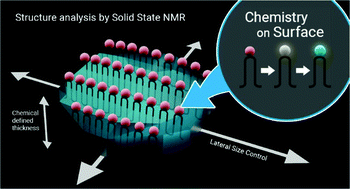
Polym. Chem., 2020,11, 7235-7243
https://doi.org/10.1039/D0PY01352H
Core hyper-cross-linked star polymers from block polymer micelle precursors
Hyper-cross-linking of a core of block polymer micelles produces core cross-linked polymer with a spacious hyper-cross-linked core, which is solution-processible.

Polym. Chem., 2020,11, 7178-7184
https://doi.org/10.1039/D0PY01225D
Effects of crystallinity and dispersity on the self-assembly behavior of block co-oligomers in water
Dispersity and crystallinity affect the dimensions of lamellar structures formed by amphiphilic block co-oligomers in water as well as the reproducibility of sample formation; spherical and cylindrical morphologies are less affected.
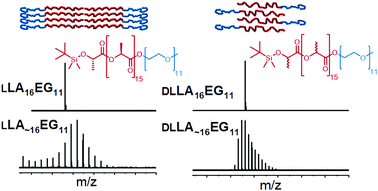
Polym. Chem., 2020,11, 7170-7177
https://doi.org/10.1039/D0PY01161D
DFT-calculation-assisted prediction of the copolymerization between cyclic ketene acetals and traditional vinyl monomers
The ring-opening polymerization of cyclic ketene acetals (CKAs) and vinyl monomers is an elegant method to produce degradable copolymers. Owing to DFT calculations, we are now able to better understand the reactivity of CKAs & common vinyl monomers.
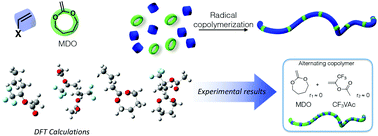
Polym. Chem., 2020,11, 7159-7169
https://doi.org/10.1039/D0PY01179G
Exploring the difference of bonding strength between silver(I) and chalcogenides in block copolymer systems
The order of Ag(I)–S < Ag(I)–Se < Ag(I)–Te bond strength was confirmed by single-molecule force spectroscopy (SMFS) with quantum chemical studies.
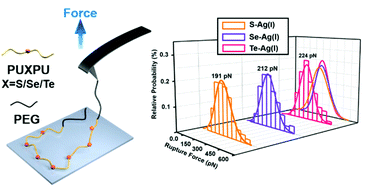
Polym. Chem., 2020,11, 7087-7093
https://doi.org/10.1039/D0PY01201G
Semifluorinated, kinked polyarylenes via direct arylation polycondensation
The Tg of semifluorinated polyarylenes made via DAP is varied between 35–195 °C depending on side chain, but solubilities are much less side chain dependent. This is explained by interactions between alkoxyphenyl and tetrafluorobenzene units.

Polym. Chem., 2020,11, 6928-6934
https://doi.org/10.1039/D0PY00973C
Insight into the synthesis of N-methylated polypeptides
The ring-opening polymerization of α-substituted N-methylated N-carboxy anhydrides is reported. The polymerization was tested using various amino acids and initiators, and was found to be limited by the steric demand of N-methylated compared to conventional amino acids.

Polym. Chem., 2020,11, 6919-6927
https://doi.org/10.1039/D0PY01055C
Time-dependent covalent network formation in extrudable hydrogels
Shear-thinning hydrogels that utilize thiol-Michael chain-extension and free radical polymerization have a tunable stretchability.
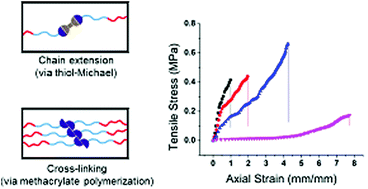
Polym. Chem., 2020,11, 6910-6918
https://doi.org/10.1039/D0PY01129K
Functional polyimides based on diamine containing diarylethylene moieties and their photochromic mechanism studies
Diarylethylene (DTE) bearing polyimides showed reversible photochromic behaviors and photoluminescence “on/off” effects, expanded application conditions of photochromic polymers and enhanced tolerance as electronic devices in extreme environments.

Polym. Chem., 2020,11, 6701-6707
https://doi.org/10.1039/D0PY01084G
Pentafluorophenyl-based single-chain polymer nanoparticles as a versatile platform towards protein mimicry
Pentafluorophenyl-single chain polymer nanoparticles are readily conjugated with functional amines enabling facile SCNP modification, adjustment of physicochemical properties, and even protein mimicry.

Polym. Chem., 2020,11, 6056-6065
https://doi.org/10.1039/D0PY00922A
Catechol-functionalized sequence-defined glycomacromolecules as covalent inhibitors of bacterial adhesion
Herein, we present the synthesis of catechol functionalized sequence-defined glycomacromolecules that can covalently block the binding site of lectins and bacterial adhesins.
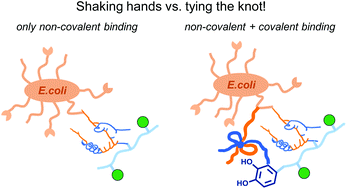
Polym. Chem., 2020,11, 6091-6096
https://doi.org/10.1039/D0PY00975J
Identifying competitive tin- or metal-free catalyst combinations to tailor polyurethane prepolymer and network properties
Polyurethane-based mastics, industrially obtained via a prepolymerization/crosslinking process, benefit from catalyst selection at both stages.

Polym. Chem., 2020,11, 5725-5734
https://doi.org/10.1039/D0PY00864H
A dual drug-based hyperbranched polymer with methotrexate and chlorambucil moieties for synergistic cancer chemotherapy
Dual drug-based hyperbranched polymer micelles simultaneously containing methotrexate and chlorambucil were constructed for synergistic cancer chemotherapy.
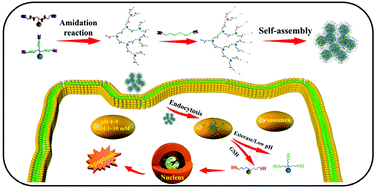
Polym. Chem., 2020,11, 5810-5818
https://doi.org/10.1039/D0PY00862A
Kinetics and mechanisms of polycondensation reactions between aryl halides and bisphenol A
Computational and experimental verification of a second-order rate expression for polysulfones synthesized using diphenyldichloro sulfone versus a third-order rate expression for polysulfones synthesized using diphenyldifluoro sulfone.
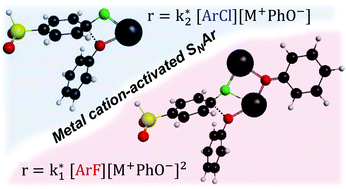
Polym. Chem., 2020,11, 5078-5087
https://doi.org/10.1039/D0PY00740D
Impacts of performing electrolysis during organocatalyzed atom transfer radical polymerization
An electrochemical variant of organocatalyzed atom transfer radical polymerization (O-ATRP) is developed and investigated.

Polym. Chem., 2020,11, 4978-4985
https://doi.org/10.1039/D0PY00643B
Sequential and alternating RAFT single unit monomer insertion: model trimers as the guide for discrete oligomer synthesis
A complete set of model trimers and their synthetic kinetics are established to guide the synthesis of diverse sequence-defined polymers.

Polym. Chem., 2020,11, 4557-4567
https://doi.org/10.1039/D0PY00390E
About this collection
Polymer Chemistry is proud to present this 2021 Pioneering Investigators collection. This collection gathers the very best work from mid-career researchers who have firmly established themselves in the field of polymer chemistry and continuously publish creative, innovative work. The 2021 Polymer Chemistry Pioneering Investigators were individually nominated by members of the journal Editorial and Advisory Boards, and previous Pioneering Investigators, in recognition of their achievements as pioneers of the field.
New articles will be added to this collection as they are published.
Congratulations to all those whose work is featured. Join us in celebrating their contributions!